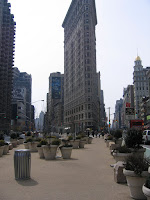 I recently spent a day in New York City and took the opportunity to visit Madison Square, where the NYC DOT has reclaimed portions of the roadway for pedestrians. These improvements are a part of a new set of policies implemented by Janette Sadik-Kahn which demonstrate the feasibility of remaking streets for people instead of cars.
I recently spent a day in New York City and took the opportunity to visit Madison Square, where the NYC DOT has reclaimed portions of the roadway for pedestrians. These improvements are a part of a new set of policies implemented by Janette Sadik-Kahn which demonstrate the feasibility of remaking streets for people instead of cars.The project at Madison Square is essentially a demonstration project. All of the work was done with temporary materials, but the effect is great nonetheless. I visited on a cold March morning so the expanded public space was not particularly busy, but folded umbrellas and stacked tables hinted at the activity one might see in warmer weather.

The view looking south
along Broadway's former lanes
The public space at Madison Square was reclaimed by simplifying the intersection of Broadway, Fifth Avenue, and 23rd Street. By eliminating the diversion of traffic from southbound Broadway onto southbound Fifth and the diversion of traffic from southbound Fifth onto southbound Broadway, some 37,000 square feet of public plazas was created.
You can view NYC's proposal for Madison Square here.

Looking north from the
former Broadway roadbed
Additional benefits included shorter crosswalks, more direct pedestrian routings, fewer gaps in the bike network, and simplified bus routings. The new plazas help to repair the urban fabric by encouraging pedestrians to cross Fifth and Broadway. Another improvement is the excellent viewpoint for photographers wishing to capture the Flatiron Building. But most importantly, NYC DOT has shown that reclaiming territory formerly only open to automobiles won't cause the world to end. The project is now being expanded to include Herald Square and Times Square.


New public space west of Madison Square
Hopefully New York's dedication to returning the public right-of-way to all of the public will catch on. Many places here in Washington could certainly use road diets. Personally, I think sections of Pennsylvania Avenue between Georgetown and the White House would be good candidates for this type of public plaza.










No comments:
Post a Comment